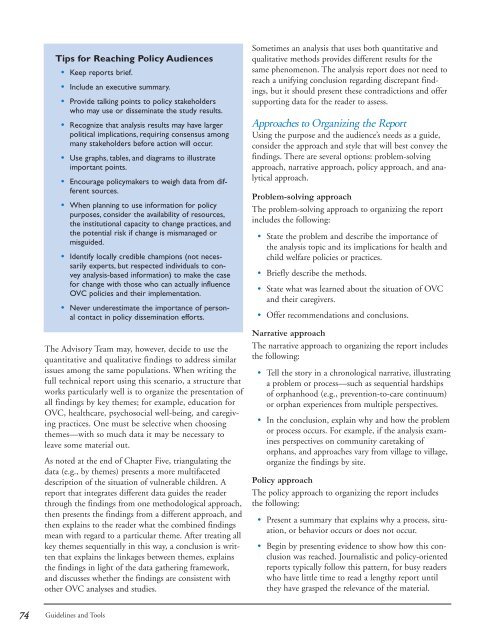Conducting a Participatory Situation Analysis of.pdf - Global HIV ...
Conducting a Participatory Situation Analysis of.pdf - Global HIV ...
Conducting a Participatory Situation Analysis of.pdf - Global HIV ...
You also want an ePaper? Increase the reach of your titles
YUMPU automatically turns print PDFs into web optimized ePapers that Google loves.
Tips for Reaching Policy Audiences<br />
• Keep reports brief.<br />
• Include an executive summary.<br />
• Provide talking points to policy stakeholders<br />
who may use or disseminate the study results.<br />
• Recognize that analysis results may have larger<br />
political implications, requiring consensus among<br />
many stakeholders before action will occur.<br />
• Use graphs, tables, and diagrams to illustrate<br />
important points.<br />
• Encourage policymakers to weigh data from different<br />
sources.<br />
• When planning to use information for policy<br />
purposes, consider the availability <strong>of</strong> resources,<br />
the institutional capacity to change practices, and<br />
the potential risk if change is mismanaged or<br />
misguided.<br />
• Identify locally credible champions (not necessarily<br />
experts, but respected individuals to convey<br />
analysis-based information) to make the case<br />
for change with those who can actually influence<br />
OVC policies and their implementation.<br />
• Never underestimate the importance <strong>of</strong> personal<br />
contact in policy dissemination efforts.<br />
The Advisory Team may, however, decide to use the<br />
quantitative and qualitative findings to address similar<br />
issues among the same populations. When writing the<br />
full technical report using this scenario, a structure that<br />
works particularly well is to organize the presentation <strong>of</strong><br />
all findings by key themes; for example, education for<br />
OVC, healthcare, psychosocial well-being, and caregiving<br />
practices. One must be selective when choosing<br />
themes—with so much data it may be necessary to<br />
leave some material out.<br />
As noted at the end <strong>of</strong> Chapter Five, triangulating the<br />
data (e.g., by themes) presents a more multifaceted<br />
description <strong>of</strong> the situation <strong>of</strong> vulnerable children. A<br />
report that integrates different data guides the reader<br />
through the findings from one methodological approach,<br />
then presents the findings from a different approach, and<br />
then explains to the reader what the combined findings<br />
mean with regard to a particular theme. After treating all<br />
key themes sequentially in this way, a conclusion is written<br />
that explains the linkages between themes, explains<br />
the findings in light <strong>of</strong> the data gathering framework,<br />
and discusses whether the findings are consistent with<br />
other OVC analyses and studies.<br />
Sometimes an analysis that uses both quantitative and<br />
qualitative methods provides different results for the<br />
same phenomenon. The analysis report does not need to<br />
reach a unifying conclusion regarding discrepant findings,<br />
but it should present these contradictions and <strong>of</strong>fer<br />
supporting data for the reader to assess.<br />
Approaches to Organizing the Report<br />
Using the purpose and the audience’s needs as a guide,<br />
consider the approach and style that will best convey the<br />
findings. There are several options: problem-solving<br />
approach, narrative approach, policy approach, and analytical<br />
approach.<br />
Problem-solving approach<br />
The problem-solving approach to organizing the report<br />
includes the following:<br />
• State the problem and describe the importance <strong>of</strong><br />
the analysis topic and its implications for health and<br />
child welfare policies or practices.<br />
• Briefly describe the methods.<br />
• State what was learned about the situation <strong>of</strong> OVC<br />
and their caregivers.<br />
• Offer recommendations and conclusions.<br />
Narrative approach<br />
The narrative approach to organizing the report includes<br />
the following:<br />
• Tell the story in a chronological narrative, illustrating<br />
a problem or process—such as sequential hardships<br />
<strong>of</strong> orphanhood (e.g., prevention-to-care continuum)<br />
or orphan experiences from multiple perspectives.<br />
• In the conclusion, explain why and how the problem<br />
or process occurs. For example, if the analysis examines<br />
perspectives on community caretaking <strong>of</strong><br />
orphans, and approaches vary from village to village,<br />
organize the findings by site.<br />
Policy approach<br />
The policy approach to organizing the report includes<br />
the following:<br />
• Present a summary that explains why a process, situation,<br />
or behavior occurs or does not occur.<br />
• Begin by presenting evidence to show how this conclusion<br />
was reached. Journalistic and policy-oriented<br />
reports typically follow this pattern, for busy readers<br />
who have little time to read a lengthy report until<br />
they have grasped the relevance <strong>of</strong> the material.<br />
74<br />
Guidelines and Tools















